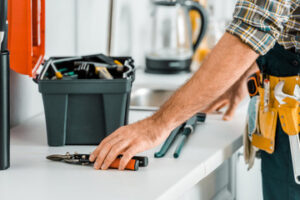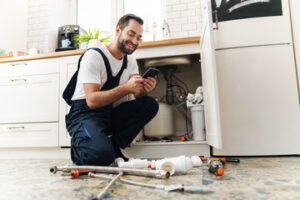Plumbers are responsible for the installation, maintenance, and repair of the pipes and fixtures that deliver water, gas, and waste disposal services in homes and businesses. They also work with architects and construction teams to design plumbing systems for new buildings.

A career as a plumber offers good job security and long-term growth potential. Contact Plumbers Bradenton for more information.
Installing plumbing fixtures and fittings is a key part of plumbers’ duties. They may work on a variety of projects, including kitchen and bath renovations, new home construction, and water heater upgrades. Before beginning any installation, a plumber checks local codes and regulations to ensure compliance with safety standards. They also inspect the site and gather necessary tools and materials. Once the job starts, a plumber may disconnect and shut off water supplies to prevent leaks during the process. They use a variety of hand and power tools to cut, shape, and fit pipes, and apply various types of sealants and adhesives. After installation, a plumber may test the new system for proper function and flow.
Plumbers who specialize in residential services work on homes and apartment buildings. They repair, install, and maintain systems for faucets, toilets, showers, sinks, dishwashers, and water heaters. They often use specialized tools to inspect hard-to-reach spots, such as behind walls and under floors. When working on new construction, plumbers follow blueprints and building specifications to lay out piping and connect fixtures. They also make sure plumbing conforms to zoning and environmental regulations.
Commercial and industrial plumbers deal with larger-scale plumbing systems in office buildings, retail stores, hospitals, manufacturing plants, and power plants. These systems are usually more complex than residential ones and require a higher level of training and knowledge to install and repair. Industrial plumbers may also work with specialized equipment like boilers and cooling towers.
To become a plumber, you typically need a high school diploma or equivalent and complete an apprenticeship program. The apprenticeship allows you to learn hands-on skills and provides on-the-job experience under the guidance of a master plumber. You must also pass a state licensing exam to become certified as a plumber. Some states also require plumbers to obtain a license before performing certain jobs or using specific tools. Additional qualifications include physical stamina, good communication skills, and the ability to problem-solve.
Maintenance
Performing regular maintenance on plumbing fixtures and pipes helps to prevent problems like leaks, clogs, and water damage. It also ensures that water supply lines bring clean, fresh water into homes and that wastewater is properly removed from sewage systems. Plumbers can inspect a home’s plumbing system using tools to check for rust, corrosion, broken or disconnected pipes, and more. In addition, they can install new fixtures and appliances such as sinks, showerheads, toilets, and water heaters. They also advise homeowners on energy efficient and environmentally friendly pipe materials and fixtures.
Residential plumbers inspect and repair plumbing systems in homes and apartments. They also work on larger plumbing systems in commercial and industrial buildings. Plumbers working in these environments often collaborate with construction teams, architects, and engineers to ensure that the plumbing is seamlessly integrated into building projects.
Inspecting a plumbing system involves checking all of the water supply lines, drain pipes and p-traps for leaks, cracks, proper slope, and signs of rust or contamination. They also check all faucets, showerheads, toilets and appliances for leaks, unusual noises or spraying water, proper installation, and power consumption. In addition, they test for adequate water pressure and evaluate the condition of the water heater, including its age, venting, and safety valves.
When a homeowner suspects a problem, they should contact a licensed plumber immediately. These professionals have the training, specialized tools, and hands-on experience needed to quickly identify and fix issues with plumbing fixtures and pipes. They can use high-tech methods like camera pipe inspections to check hard-to-reach places and detect issues that might not be visible to the naked eye.
The plumbing industry is constantly evolving, and plumbers must keep up with new technologies, tools, and equipment. They must also adhere to strict safety protocols when working with hazardous materials and in confined spaces. Despite the challenges, being a plumber can be a very satisfying career for those who enjoy working with their hands and solving problems. With a growing demand for plumbing services, there are many opportunities for those looking to enter the field.
Repair
Whether it’s a leaky faucet or a cracked pipe, plumbers are called on to repair a variety of plumbing fixtures and systems. They are skilled at identifying the cause of problems, and can make sure that any repairs are made correctly the first time. Plumbers also provide routine maintenance services, such as cleaning drains and replacing worn-out parts.
Leaking pipes are a serious issue that can lead to flooding, water damage, and costly repairs if left unattended. A plumber will inspect the entire plumbing system to identify any problem areas, such as rust or corrosion on pipes and fittings, loose connections, water flow restrictions, or improper fixture installation. Once the plumber has inspected the entire system, they will provide recommendations for any necessary repairs or replacements.
A professional plumber will also be able to spot potential safety issues, such as gas leaks, exposed electrical wiring, or cross-contamination of water systems. By identifying these risks, plumbers can ensure that the property is safe for its occupants.
Some plumbing problems are difficult to detect, especially when they occur underground or in the ceiling of a home or commercial building. Plumbers are skilled at finding these problems without tearing into walls or digging up the yard, and can often fix them with minimal disruption to the surrounding area.
If you have a stubborn leak or clog, there are some things you can try before calling a plumber. For example, if your shower head or hose bib is stuck because of hard water, try soaking the fixture in vinegar to loosen any mineral deposits. You can also use a hair dryer or heat gun to warm up the threaded area, which will allow you to remove the fixture more easily.
Every plumbing system will require repairs at some point, but regular maintenance can help you avoid costly breakdowns and extend the life of your appliances and pipes. Plumbers are skilled at repairing a wide range of plumbing issues, from leaky faucets to clogged toilets and more complex problems like faulty boilers. By contacting Black-Haak for regular inspections and maintenance, you can save yourself from expensive repairs down the road.
Design
Every house, building, and public structure requires a well-functioning plumbing system to supply clean water and remove waste. Plumbers design, install, and repair these systems, ensuring they are safe and effective for occupants’ health and comfort. This skilled trade offers a range of career options and opportunities to pursue specializations in residential, commercial, or industrial plumbing.
While most people associate plumbers with unclogging toilets and fixing leaky faucets, this profession also involves a wide array of other tasks. For example, plumbers can design piping systems that deliver chemicals and other hazardous materials. They can also assemble, install, and repair systems that connect heating and cooling equipment. In addition, plumbers can inspect sewer lines and other public water infrastructure to ensure they are free of obstructions and in good condition.
Plumbing contractors often work in new construction, collaborating with architects, builders, and other construction professionals to design and install plumbing for entire buildings or structures. These projects involve reading blueprints, laying out piping, and installing fixtures and appliances according to specifications. They may also be responsible for coordinating with electrical engineers to ensure that lighting and other electrical systems are properly integrated into plumbing structures.
Some plumbers choose to focus on eco-friendly and sustainable plumbing solutions. These professionals can recommend and install low-flow toilets, energy-efficient showerheads, and rainwater harvesting systems. They can also help clients reduce their carbon footprint by explaining the benefits of green plumbing practices.
The skills that are most important for a plumber to have include physical stamina, problem-solving abilities, and a strong work ethic. They must be comfortable working with tools and have the ability to follow instructions closely. Plumbing is a highly technical field, and plumbers must stay up-to-date on current technologies, regulations, and equipment.
Many plumbers work as independent contractors or own their own businesses. These opportunities offer increased flexibility and control over work schedules and project selection. However, they also require more self-motivation and management skills than salaried positions do. Some plumbers are on call during emergencies, which can disrupt personal lives and cause stress. Therefore, it is important for plumbers to find a work-life balance that includes adequate downtime.


